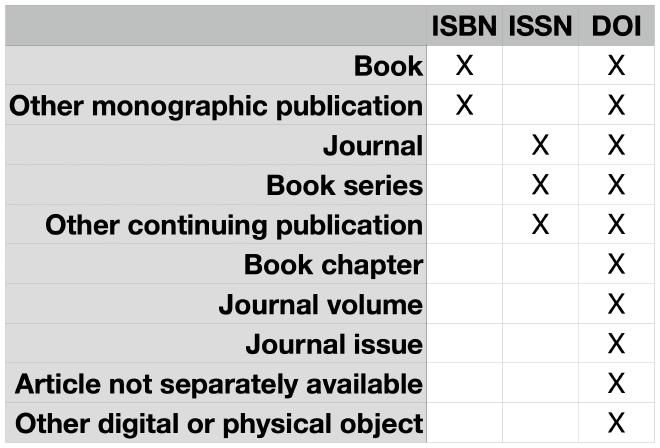In the world of academic publishing, the quality of a journal is frequently measured by how often its articles are cited. For the good of a journal’s reputation, and the reputations of its authors, it’s therefore essential that the journal be uniquely identifiable. Researchers need to be able to refer clearly to this article, published in that journal by those authors. And if you’re a publisher funding your journal with subscriptions, librarians need to be confident they’re paying for — and receiving — the content their faculty are actually using. It’s your job to make all of this possible.
That’s where identifiers come in. Using existing, internationally accepted systems, you can assign every work you publish its own unique identifier. The exact kind you use, and how you get it, depends on the type of work and where you’re publishing it. And by referring to this identifier, anyone — author, librarian, or publisher — can be sure they know which article or journal is which.
Different identifiers for different situations… #
For a publisher of academic journals, the most important identifiers to understand are the ISSN and the DOI.
ISSNs, or International Standard Serial Numbers, are managed by the ISSN International Centre. It’s the main way that libraries, in particular, identify serial publications. If you intend to publish a journal — or, indeed, any set of works published on an ongoing basis without a planned endpoint — you’ll need to get an ISSN for it.
DOIs, or Digital Object Identifiers, are managed by the DOI Foundation. In theory, you can assign a DOI to pretty much anything. But if you’re publishing academic journals, you’ll most likely get DOIs for the various discrete units of content you publish — mostly individual articles, journal issues, and the journal series themselves. DOIs are not used as commonly by, say, public libraries or writers of fiction, but they are a very important tool for researchers and their institutions, especially those that intend to publish online.
ISSN and DOI are best thought of as separate systems that provide identification for different (though overlapping) categories of publication, and which are administered and maintained by different organizations. This last part is important — an organization that assigns ISSNs typically only assigns ISSNs; it won’t be able to help you get a DOI.
Sidebar: What about the ISBN? #
ISBN stands for International Standard Book Number, and it is indeed another identifier system. It’s used for “monographic” publications — that is, essentially, publications (in any format) that are made available as complete units. Publishers of monographs and conference proceedings often get ISBNs for those works, but if you’re just starting out as a journal publisher, you probably won’t be working with them just yet. When you do, though, a lot of the same basic principles will apply as for ISSNs and DOIs; so once you’ve got a handle on those, you’ll have a good starting point for working with ISBNs, too.

…but not so different #
These systems do share some common elements. Obviously, they share the same goal: each ISSN and DOI (and ISBN!) is intended to be unique, and to point to a single discrete unit of work. Also, each system is organized by an international body that is the sole source of truth as to which identifier belongs to which publication.
This means that these systems work across borders — you don’t need to get a separate DOI for every country where your article is available, and you don’t need to worry about overseas libraries knowing where to look for your ISSN. It’s the job of the central international body to ensure your data is accessible to researchers and research databases worldwide.
However, in most cases, publishers and other creators work directly with one of a number of smaller organizations, or “agencies”. These agencies assign individual identifiers to specific works, and then communicate that information to the central administrative body.
To get each type of identifier, therefore, you’ll need to get in touch with a particular agency — usually, by creating a user account on their platform. Then, for each individual work that you publish, you’ll submit basic information such as title, authors or other contributors, and publication format. The agency will record this information, linking it to your new identifier.
And, of course, each identifier you get should ultimately be displayed on — and used when talking about — the relevant work. That way, if a reader wants more information about your publication, they can search by ISSN or DOI in their local library system or online, and find all the details they need.
What’s next? #
We’ll go over the practicalities of getting and using identifiers in future installments of The MSP Guide to Journal Publishing. Pretty quickly, you should have a good handle on how to make sure your readers know they’re reading, citing, and sharing your publication, and no one else’s.
Header image by Erol Ahmed, available from Unsplash. Free to use under the Unsplash license.